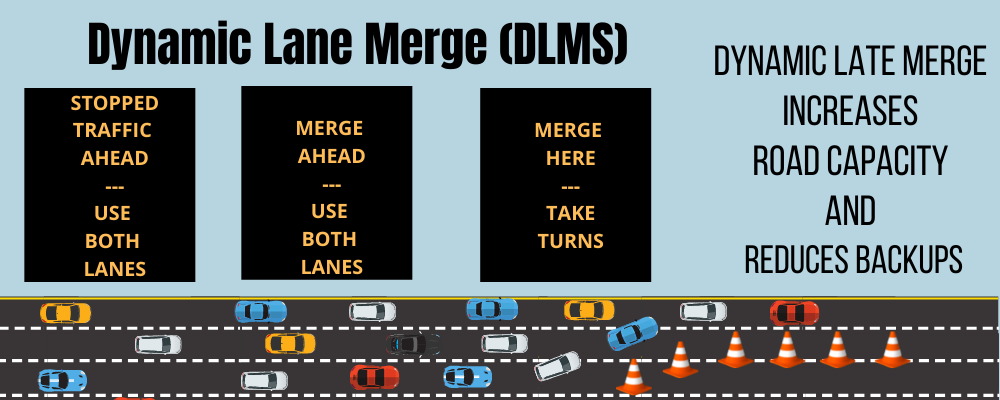Dynamic Lane Merge Systems (DLMS) are designed to improve safety and efficiency on roadways with a lane merge. When traffic is congested, a DLMS system advises motorists to merge late. This reduces backups and increases road capacity and throughput.
In low-traffic, free-flow conditions, it makes sense for cars to merge early, before the lane taper, as they find openings in traffic.
In high-volume congested conditions, early merge generates long queues and reduces road capacity and safety. Speed differentials between the open and closed lane increase, as some drivers speed forward in the closed lane, darting into the open lane at the last minute. This creates unsafe conditions.
DLMS Systems encourage drivers to merge in the optimal pattern for the current road conditions.
According to FHWA Guidance, DLMS can improve operations, reduce delay and queue lengths, and increase safety in the work zone.
Benefits Found in Studies:
-
- Higher capacity and throughput1,2,3,5
- Reduced queue lengths3,4,6 and faster queue discharge5
- Reduced travel time delay2
- Decreased aggressive behavior4
- Improved safety4
- Reduces driver confusion while merging4
- Reduces speed differentials between lanes3,4
QLynx Dynamic Lane Merge Systems:
- Each changeable message sign or solar-powered trailer is individually integrated with the system.
- Allows remote control of the system from anywhere.
- Allows manual override of the messages displayed on the signs. For example, the user can remotely display special messages, such as “ACCIDENT AHEAD”; or “FREEWAY CLOSED AT RT XXX”, when a quick and effective incident management tool is needed.
- Provides real-time information via the cloud so it can be viewed on any computer or mobile device.
References:
1. Guidance for the Use of Dynamic Lane Merging Strategies, FHWA
https://www.workzonesafety.org/fhwa_wz_grant/atssa/atssa_dynamic_lane_merging
2. Evaluation of the Dynamic Late Lane Merge System at Freeway Construction Work Zones Final Report, Submitted to Michigan DOT by Wayne State University Transportation Research Group, 2007
3. Dynamic Late Merge Control at Highway Work Zones: Evaluation, Observations, Suggestions, Kang, Chang, Paracha, TRB, 2006
4. Evaluation of the 2004 Dynamic Late Merge System, Prepared for Minnesota DOT by URS Corporation, 2004
5. Two Simplified Dynamic Lane Merging System (SDLMS) for Short Term Work Zones, Harb, Radwan, Ramasamy, Abdel-Aty, Pande,
Shaaban, Putcha, TRB, 2009
6. Understanding Road Rage: Evaluation of Promising Mitigation Measures, Walters, Cooner, Texas Transportation Institute, 2001.

